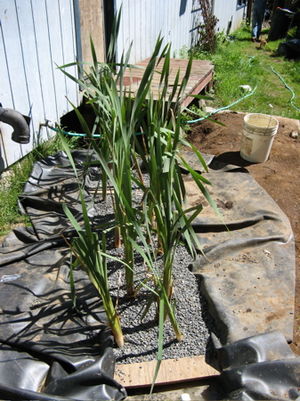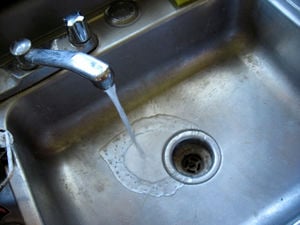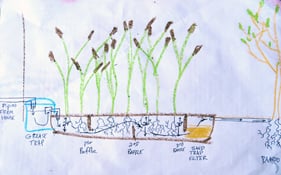Millcreek greywater

With most American homes today, all used waters are flushed down the toilet and go on to the water treatment plant. Unfortunately, only some of those waters deserve such intensive treatment. Greywater is a small scale alternative, in which "greywater" from some parts of the used water supply is kept separate, kept onsite and introduced into a working biotic environment, which will break down this water into a safe, (though non-potable) reusable level. This "biotic" treatment is carried out by freshwater marsh plants, Cattails (Typha Spp.) and Rushes (Scirpus Spp.) ours uses Cattails native to this area, Thypha Spp. wild crafted with expressed permission from Fresh Water Farms. It is important to note that greywater DOES NOT INCLUDE ANY FECAL MATERIAL. Fecal content renders a water BLACKWATER.

Plan/Design[edit | edit source]
This Engineering project is creating a residential greywater processor for a house of three persons. In so doing, our goal has been to become educated on the greywater construction process, analyze the pros and cons of previous greywater projects and implement a functional, economically viable greywater processor.
- This Greywater system processes water from: 1 shower, 1 washing machine and 1 sink.
- This Greywater system is 9'long x 20" wide.
- Its depth grades from 20" at the shallowest to 28" at it's deepest.
- This Greywater system has 3 baffles: 2 underpasses, and 1 overpass.
The greywater from our sources enters a grease trap, where all large particulates are separated from the influent. The influent then enters the subsurface peagravel substrate, where it begins to flow past the marsh plants root systems and their micro-organism counterparts. Three baffles inserted into the system serve as blocks to this flow, forcing the water to flow through small passageways. This therefore maximizes surface area in a small contained area. This system has been designed so that water takes approximately 6-10 days to pass through the system. The effluent then passes through a sand filter and then out into a contained bamboo grove.
Kudos for this project go out to four helpful people:
Rick from Freshwater Farms: Plant Specialist. Kendra Cecil: Former CCAT Resident and Greywater afficionada. Kyle Perry: Greenbuilder and plumber. Lonny Grafman: Mentor, Advocate, greywater Muse.

Construction[edit | edit source]
Digging[edit | edit source]
After months of planning, discussion and research getting our hands dirty was a blessing. Originally we had proposed a system which would have treated three bathrooms, a kitchen sink and one washer. Due to plumbing lag-gistics, convenience and cost we chose to only incorporate one bathroom sink, one shower and the washer into the system. This significantly shrunk the size of the trench we had to dig. After careful calculation, the original design for a 14'x 2.5'x 3' trench was downsized to only 9' long and 20" wide with a starting depth of 20" which gently slopes to its final depth of 26". The effluent then passes through a sand filter before flowing out of the system and into a contained bamboo grove.
-
Before photograph of site
-
Planted Cattails
Lining[edit | edit source]
Lining the trench was a bit tricky because we decided to place one bottom baffle BELOW the pond liner. (This was a totally innovative....and risky, yet totally calculated leap into the frontiers of greywater). A bit of slack had to be left on either side of the baffle so as not to rip the lining with the weight of the gravel. After some carfull kneeding and pulling we had a snug fit and were ready to install the last two hanging baffles.
-
Effluent outtake to bamboo grove
-
path above drain to bamboo grove
Filtration[edit | edit source]
This greywater design incorporates a grease trap to reduce particulate introduction to the greywater processor. Influent from the house's washing machine pours through an initial mesh filter. Then, the water sinks down and up into a grease trap unit, which allows only water to percolate through the piping and on into the greywater marsh.
-
Aerial view of the grease trap
-
Aerial view of initial screen filter
-
Fig 1:drain
-
Fig 2: drain cover
Baffles[edit | edit source]
Oh baffles. How we love thee. After careful consideration in regards to baffle design we decided once again to go on naturally intuitive instincts with our custom designed "hanging" baffle system. With only two baffles left after the lining was installed, completion was a snap. Of course the final installation, as with every other step, was completed with care as to not damage the lining and allow for maximum overall efficiency in the finished system.
Filling[edit | edit source]
With great care and physical prowess we carried the pea gravel in five gallon buckets the fifty feet between our gravel pile and our innovative custom designed, home built waste-water treatment system. When pouring the gravel into the delicate system one must also pour his or her heart and soul into that hole cultivating a loving and compassionate home for a newly born living system to achieve maximum water treatment capability. Cattails should be planted 6" to 8" from the surface,
-
Avery measures the depth
Planting[edit | edit source]
To use a greywater processor in lieu of a traditional septic system, it is the aquatic plants, and more specifically the microorganisms which live amongst the root systems of these aquatic plants which are responsible for the vastly improved water quality. For this project's plants, we turned to aquatic plant specialist Rick, of Freshwater Farms. Rick is extremely knowledgeable regarding marsh species and steered us into using the native plant species Cattail (Typha spp.) These plants are extremely adept at purifying water in a very short amount of time. We had the opportunity to visit Freshwater Farms, to go out into the habitat and were permitted to select seventeen right out of the living marsh system. For such an endeavor we recommend procuring permission to wild harvest such plants. To dig the Cattails up, we used pitchforks. (It is important to carefully pull up each cattails with it's two taproots intact.) For this sub-surface greywater system, we planted them in a substrate of pea gravel. These plants are relatively easy to plant and need to simply be submerged more than one foot into the substrate.
-
Gathering Cattails at Freshwater Farms
Costs[edit | edit source]
Following are the costs of the system construction.
| Material | Cost |
|---|---|
| Pond liner | $155 |
| Plants | $60 |
| Grease Trap | $30 |
| Gravel/Sand | $85 |
| Plumbing | $100 |
| Labor (in Kind) | $700 |
| Material Total: | $430 |
This cost is still too much for much of the world. Mostly due to the pond liner. Other materials could be found on site, such as gravel, sand and plants, thereby further reducing the total cost of implementation.
Time[edit | edit source]
| Phase | Cost in hours |
|---|---|
| Planning | 27 |
| Research | 14 |
| Purchasing | 5 |
| Digging | 5 |
| Lining | 1 |
| Baffle Construction | 3 |
| Grease Trap Construction | 7 |
| Installation | 4 |
| Planting | 4 |
| Time Total: | 70 Hours |
Testing[edit | edit source]
It is important to note that greywater is best fit to serve the hydration of non-edibles, that is, trees, shrubs and such which humans will not directly ingest. That said, we will periodically test for fecal chloroform presence. Our system should not have any such residues as it will be water run-off from our washing machine, sink and shower. (If you have infants etc... in the home, care should be taken). Black water can create such fecal-like conditions if water should stand stagnant for more than a month. 3 plus persons dwelling at this residence will provide plenty of fresh movement to this small greywater run.
Conclusions[edit | edit source]
Countless success stories give credence to the viability of home-built greywater processors. So long as no Fecal matter enters the system, and the system is sized somewhat appropriately, it will irrigate on-site and save the energy of municipal processing. Allowing for a seal-off tie-in when construing such a system is wise, so that a greywater system can be shut off in the unforeseen future.









